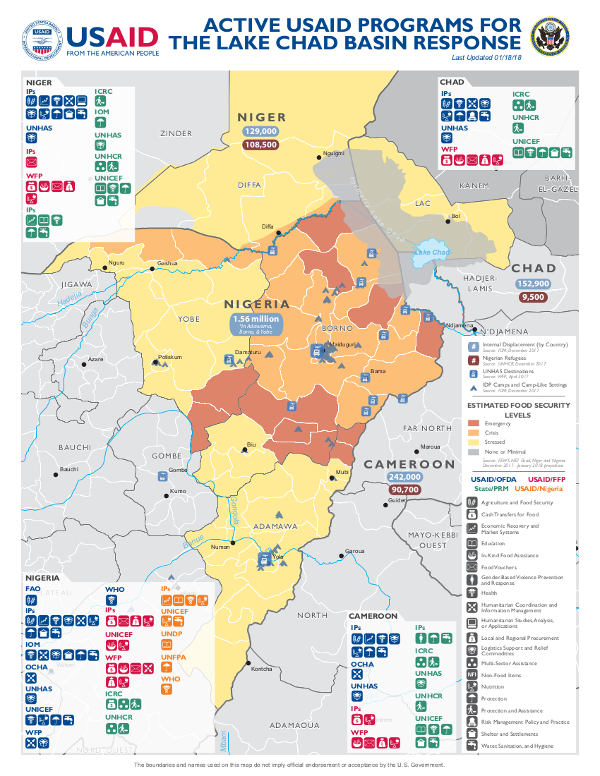- What We Do
- Agriculture and Food Security
- Democracy, Human Rights and Governance
- Economic Growth and Trade
- Education
- Environment and Global Climate Change
- Gender Equality and Women's Empowerment
- Global Health
- Humanitarian Assistance
- Transformation at USAID
- Water and Sanitation
- Working in Crises and Conflict
- U.S. Global Development Lab
Speeches Shim
January 18, 2018
Highlights
UN reports uptick in Boko Haram-related insecurity across Lake Chad Basin during the second half of 2017
Military operations, insecurity displace populations in northern Borno State
Food analysis projects continued food insecurity for vulnerable populations in Cameroon
Lake Chad Map - 01-18-2018 ![]() (pdf - 815k)
(pdf - 815k)
Numbers At A Glance
8.5 million
1.56 million
129,000
242,000
152,900
208,700
Humanitarian Funding
For the Lake Chad Basin Response
| USAID/OFDA | $134,497,117 |
| USAID/FFP | $314,910,422 |
| State/PRM | $71,090,000 |
| USAID Nigeria | $6,182,734 |
| Total | $526,680,273 |
KEY DEVELOPMENTS
Boko Haram-related insecurity continues to pose grave risk for civilians in the Lake Chad Basin region, according to the UN. Following a decrease in reported attacks during the first half of 2017, the number of attacks increased during the latter half of the year, with monthly civilian casualties peaking at more than 140 in November. In Niger’s Diffa Region, Boko Haram-related civilian casualties declined from 2016; however, the number of suspected Boko Haram attacks increased from approximately 80 attacks in 2016 to more than 100 attacks in 2017.
In December, military operations and insecurity in northern Borno State prompted nearly 2,100 people to flee to Gajiram town in Nganzai local government area (LGA), according to a rapid needs assessment. New arrivals require immediate multi-sector assistance to meet basic needs. In addition, military operations and conflict in the region prompted nearly 2,000 people to relocate to more secure areas of Monguno and Nganzai LGAs from January 8–15, according to the International Organization for Migration (IOM).
The Famine Early Warning Systems Network (FEWS NET) reports that some vulnerable populations in Cameroon are facing Stressed—IPC 2—levels of food insecurity.4 FEWS NET expects highly vulnerable populations to continue facing Stressed levels between April and May, with planned humanitarian assistance preventing further deterioration of food security conditions. In addition, FEWS NET anticipates that populations in Cameroon’s Far North Region will face rising staple food prices, limited local food supply, and early depletion of household food stocks in the coming months following low agricultural production in 2017, which may exacerbate food insecurity.
REGIONAL
Although Boko Haram attacks declined during the first half of 2017, the number of attacks surged during the second half of the year, according to the UN. Between July and September, the UN reports nearly 160 suspected Boko Haram attacks, 100 of which occurred in Nigeria. In addition, the number of related civilian casualties peaked in November, with more than 140 civilian casualties reported during the month. Moreover, the UN expressed concern that the number of attacks involving the use of children as carriers of person-borne improvised explosive devices (PBIED) increased fivefold from 2016, with 135 cases reported in 2017. The forced use of women and children as carriers of PBIEDs remains a priority protection concern throughout the Lake Chad Basin.
NIGERIA
As of mid-January, the Borno State Ministry of Reconstruction, Rehabilitation and Resettlement (MRRR) had completed the construction of 11,000 houses, more than 10 schools, and 10 boreholes in Bama town, according to media. The efforts are part of the Government of Nigeria (GoN) Bama Initiative—a large-scale effort to reconstruct the conflict-affected LGA and facilitate the safe and voluntary return of internally displaced persons (IDPs) to Bama. The MRRR reported that the insurgency damaged or destroyed as much as 90 percent of houses and public buildings in the area between 2013 and 2015. In addition to the GoN’s rehabilitation and reconstruction efforts, the UN reported that a major mobile network operator restored telecommunications services in the area in mid-December. Insecurity remains a persistent threat to civilians in Bama, and civilian movement is restricted in the region, according to the UN.
In mid-December, humanitarian agencies completed the relocation of approximately 15,000 IDPs from the Bama General Hospital IDP camp to the recently established Government Science Senior Secondary School (GSSSS) IDP camp, both located in Bama town, the UN reports. IOM and the Office of the UN High Commissioner for Refugees (UNHCR) established the GSSSS site to address population congestion and restore medical services at Bama General Hospital, which had been hosting IDPs since 2015. Humanitarian organizations are working to establish basic services at the GSSSS site, including education, food assistance, health care services, and water, sanitation, and hygiene (WASH) facilities. However, the UN reports that insecurity in the area continues to be a risk to civilians, and humanitarian agencies remain concerned about inadequate shelter conditions and insufficient WASH facilities and services at the site.
Military activity in northern Borno State and insecurity along the Maiduguri–Monguno road have driven large population movements into Gajiram town in Nganzai LGA, according to an early January non-governmental organization (NGO) rapid needs assessment. In December, nearly 2,100 people arrived to nine informal IDP sites and local communities across Gajiram. The assessment identified priority needs among new arrivals, including food assistance, WASH infrastructure and services, relief commodities and emergency shelter, and ensuring the incorporation of protection principles in the delivery of assistance. In addition, the assessment found that 18 percent of children screened were experiencing acute malnutrition. Although relief actors referred cases of malnutrition to outpatient therapeutic programs (OTP) for treatment, the assessment reported a need for supplementary feeding programs and expanded OTP services for new arrivals.
In 2017, the Health Sector—the coordinating body for humanitarian health activities, comprising UN agencies, NGOs, and other stakeholders—reached nearly 3.8 million people in northeastern Nigeria’s Adamawa, Borno, and Yobe states with life-saving health assistance. The health care response included the vaccination of 2.1 million children against polio and nearly 897,000 children against cholera. The Health Sector reports that only 30 percent of health facilities in the region are functional and only 10 percent of health facilities have access to safe drinking water, leading to critical health care needs across northeastern Nigeria.
In December, a USAID/FFP NGO partner disbursed approximately $805,000 in cash-based transfers and distributed nearly 1,600 metric tons (MT) of in-kind food commodities to assist nearly 166,500 people in Borno State. The partner also screened approximately 610 children younger than five years of age and 540 pregnant and lactating women for malnutrition and conducted breastfeeding education sessions for nearly 330 pregnant and lactating women.
CAMEROON
Populations in Cameroon’s Far North Region are facing low cereal and pulse stocks due to inadequate and irregular rainfall and crop damage, FEWS NET reports. FEWS NET also projects that off-season production in the region, typically harvested between January and March, will be below average this year. Low production and disrupted market activity have contributed to sorghum and maize price increases—by 19 and 23 percent, respectively—since October.
FEWS NET reports that some vulnerable populations in Cameroon are currently experiencing Stressed—IPC 2—levels of food insecurity. In addition, some of the poorest households—facing high food prices, limited livelihood opportunities, and depleted household food stocks—will continue to experience Stressed levels between April and May, with planned humanitarian assistance preventing further deterioration. USAID/OFDA is supporting two NGOs to respond to food security needs in Far North through the provision of agricultural inputs and training on agricultural techniques and implementation of cash-for-work activities to provide income-generating opportunities and rebuild community assets.
In Far North, local authorities recently began relocating returnees from Maya Tsanaga Department’s Mozogo District to a new IDP site in Zamai District, according to the UN Children’s Fund (UNICEF). Humanitarian actors are scaling up basic services such as WASH infrastructure and health care services at the site. UNICEF is supporting the provision of basic services while continuing to advocate for the re-integration of returnees within communities of origin.
UNICEF reports that local authorities are also relocating 12,000 IDPs in Mayo Sava Department’s Kolofata District to a new IDP site, where access to basic services remains limited; approximately 3,000 IDPs have relocated to date. The UN, local authorities, and the WASH Sector are coordinating to supply water to the site, which remains the largest gap. UNICEF continues to advocate for freedom of movement for IDPs while supporting the government to ensure the provision of basic services at the new site.
Approximately 700 Nigerian asylum seekers have relocated to Minawao refugee camp—the largest refugee settlement in Far North—since early January, according to the UN. The majority of asylum seekers had lived within host communities in Mayo Tsanaga for several years after fleeing Nigeria from 2013–2014. The UN reports that local insecurity likely prompted the relocation. Approximately 59,000 refugees were sheltering at Minawao as of November, according to UNHCR.
NIGER
Suspected Boko Haram attacks resulted in 140 civilian casualties—including abductions, deaths, and injuries—in Niger’s Diffa Region during 2017, representing a significant decrease from 2015 and 2016, when the UN reported approximately 210 and 230 casualties, respectively. Despite the decline in casualties, Diffa experienced a surge in the number of suspected Boko Haram attacks in 2017. UN partners reported approximately 100 attacks in Diffa throughout the year, representing a 30 percent increase from 2016 and a 66 percent increase from 2015. The majority of attacks—more than 60 percent—occurred in Diffa Department. While insecurity persists in areas of Diffa and continues to result in humanitarian needs, other areas of the region are stabilizing, providing opportunities for early recovery activities and transitioning to development assistance.
From July–September, a USAID/OFDA partner treated nearly 5,300 children experiencing acute and moderate malnutrition in Diffa. Although the figure is nearly double the number of children admitted for treatment during the previous three-month period, the partner reports that the increase is likely attributable to a mass malaria diagnosis and treatment campaign that enabled health workers to expand malnutrition screening. During the reporting period, the partner also reached more than 50,000 people with health treatments and preventative medicine programs, including antenatal care and family planning, as well as vaccinations for children ages five years and younger.
CONTEXT
Years of conflict perpetuated by Boko Haram and Islamic State of Iraq and Syria–West Africa have triggered a humanitarian crisis in Nigeria and surrounding countries in the Lake Chad Basin region, including Cameroon, Chad, and Niger. The escalating violence—including deliberate attacks on civilians and relief workers—has displaced more than 2 million people; hindered agricultural production, livelihoods, and cross-border trade; prevented delivery of humanitarian assistance; and restricted affected populations from accessing basic services in the four countries.
The UN estimates that nearly 11 million people in the region require humanitarian assistance, including approximately 8.5 million people in northeastern Nigeria’s three most-affected states—Adamawa, Borno, and Yobe. Populations in the Lake Chad Basin remain highly dependent on emergency food assistance to meet basic food needs, in addition to requiring emergency health, nutrition, protection, shelter, and WASH interventions.
On November 10, 2016, USAID activated a Disaster Assistance Response Team (DART) to lead the U.S. Government response to the humanitarian crisis in northeastern Nigeria. USAID also stood up a Washington, D.C.-based Response Management Team to support the DART.
U.S. Chargé d’Affaires, a.i., Matthew D. Smith, U.S. Ambassador Geeta Pasi, Chargé d’Affaires, a.i., Phillip Nelson, and U.S. Ambassador W. Stuart Symington have re-declared disasters for FY 2018 due to the ongoing complex emergencies and humanitarian crises in Cameroon, Chad, Niger, and Nigeria, respectively.



Comment
Make a general inquiry or suggest an improvement.